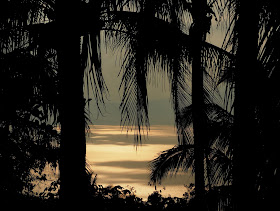However, maybe because of our body's memory and our mind's habit conditioning , i still wake up early and sleep late. I also still do not sleep during the day, and i still feel that my time is not enough. My gardening takes the first priority, and still i have many gardening tasks still undone. Once-in-a while i can go out for butterflies, but the extreme heat even in the early morning hinders my wish to go out and look for them. Aside from my hoya and hippeastrum collections, i entered into the world of figs. And this proves to be very demanding.
So for now i will post here some of the extra pictures. But i am posting the forest this time.
I started early with this view of the sea in between the coconut trees. We are 4 km from here.
This area is at least 15 minutes walk from our house or 1 km away. This area has deep ravines but many patches are planted with coconuts. I purposely come here only to see a special plant that blooms only during the dry season, in time for the heat.
I know the position of the tree so i know which part of the area to enter. Those flowers on top are my guide. That is what i am looking for.
I veered away from the single path to the area, but i encountered a clearing which is steep and slippery due to the dried plants. These are cleared to give space for those legume trees to grow, and they in turn are fed to cattle. The angle of this land can be at 50 degrees, so i had to really take care not to slip.
As i approach the tree, the beauty of the flowers become more visible. It is called the Palawan Cherry, cause lots of them are growing in Palawan. Some say it is not an endemic species, but it was brought in during the Spanish period so already here for centuries. We think it is a native species.
Years ago i found it flowering more profusely than this year, as shown by those few flowers.
Eventually i reached the tree, with this gnarled trunk. The broken branch can be because of the typhoons. It is a leguminous tree so a nitrogen fixer. I hope to find the pods for seeds, but i guess i am a bit early for that.
I saw some still good pods on the ground, remnants from last years fruits. I got some seeds, but not sure if they are still viable.
Some pods have this larva on the locule where the seeds are located. They eat the seeds and eventually pupated in the locule. I just do not know what they look like as adult moths.
This is a different tree nearby, with white bark and a lot of dried pods. So this is also a leguminous tree.
I also noticed a lot of seedlings that turn leaves darker, or reddish purple. It is their way way of coping with the very hot direct sun. Purple young leaves have pigments that protect the leaves from intense ultraviolet rays. Eventually these leaves turn green as they mature.
These seedlings are not like this during the other kinder months of the year. They are fully green. I always see them before because they are hosts to some butterfly larvae. I can say they are very good indicators of the intensity of the sun during our dry season.
It is Clausena sp. a member of the citrus family, whose leaves are aromatic when crushed.
Leaves not fully exposed to the sun are still greener. It is still early that morning, yet the leaves are already curling as a sign of deficiency in water uptake. I hope they can still wait for at least 2 more months, till the start of the rainy season.
It is also nice to visit some areas to observe conditions and responses of the plants to environmental conditions. Even if we only have two seasons, the responses of plants are still very distinct and visible.














